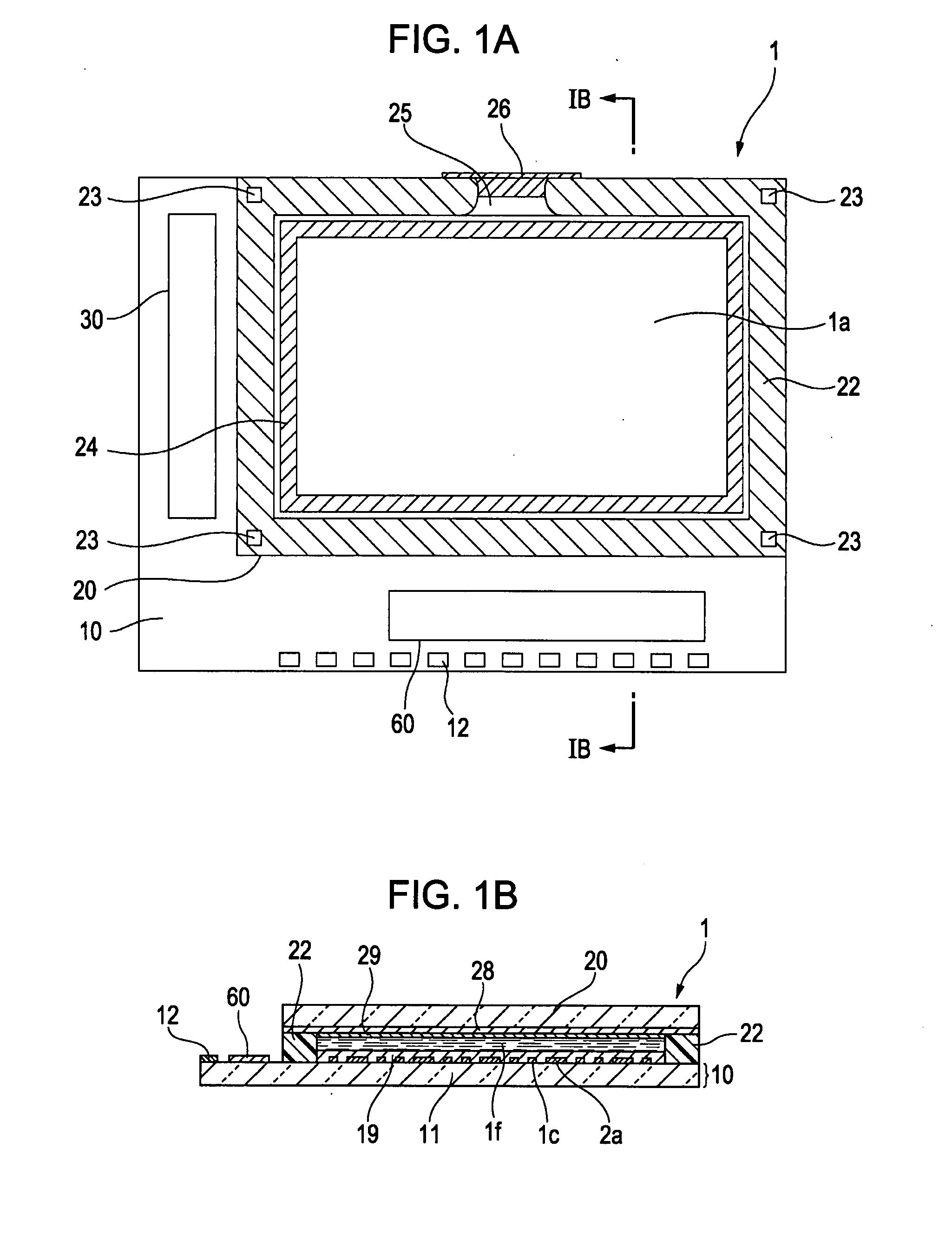Electro-optical apparatus, electronic apparatus, and method of manufacturing electro-optical apparatus
a technology of electrooptical apparatus and electronic equipment, which is applied in the direction of electrical equipment, instruments, semiconductor devices, etc., can solve the problems of low current of thin-film transistors, and inability to achieve high-speed operation in gate line driving circuits or source line driving circuits. achieve the effect of improving current characteristics, increasing thickness, and improving current characteristics of thin-film transistors
- Summary
- Abstract
- Description
- Claims
- Application Information
AI Technical Summary
Benefits of technology
Problems solved by technology
Method used
Image
Examples
embodiment 1
Configuration of Liquid Crystal Apparatus
[0048]FIGS. 1a and 1b are respectively a plan view of a liquid crystal apparatus (electro-optical apparatus) together with components formed thereon when viewed from a counter substrate and a cross-sectional view taken along line 1B-1B. The liquid crystal apparatus 1 according to the present embodiment is a transmissive active-matrix liquid crystal display apparatus of a twisted nematic (TN) mode, an electrically controlled birefringence (ECB) mode or a vertical aligned nematic (VAN) mode. In the liquid crystal apparatus 1, a device substrate 10 and a counter substrate 20 are adhered through a seal material 22 and liquid crystal 1f is held therebetween as an electro-optical material.
[0049]In the present embodiment, as described below, an active layer of thin-film transistors formed on the device substrate 10 is formed of an amorphous silicon film. As shown in FIGS. 1a and 1b, on the device substrate 10, a data line driving circuit 60 and a sc...
modified example 1 of embodiment 1
[0097]Although, in Embodiment 1, the upper hole 83 of the contact hole 89 is formed in the process of forming the contact hole shown in FIG. 6c and the insulating film 4 (the upper insulating film 4b) located at the bottom of the upper hole 83 is removed to form the lower hole 46 in the other etching process, when the thicknesses of the upper electrode 6c and the upper conductive layer 6s are large and the thickness of the insulating film 4 in which the contact hole 89 for connecting the lower conductive layer is formed is small, the contact holes 81, 82 and 89 may simultaneously formed in the process of forming the contact holes. The present embodiment is not limited to Embodiment 1 and is applicable to the following embodiments.
modified example 2 of embodiment 1
[0098]Although, in Embodiment 1, the removed region 45 in which the lower insulating film 4a is removed over the thickness direction is formed over the wide region of the driving circuit forming region of FIGS. 3b and 3c, the removed region 45 in which the lower insulating film 4a is removed over the thickness direction may be formed in the inner region spaced apart from the outer edge of a region, in which the signal line 3g and the active layer 7g overlap, by a predetermined distance, as shown in FIGS. 7b and 7c, similar to a region in which the storage capacitor 1h is formed as shown in FIGS. 7a and 7b. By this configuration, since the thick insulating film 4 can be interposed in the outer edge of the region in which the signal line 3g and the active layer 7g overlap, it is possible to ensure a sufficient gate withstanding voltage of the thin-film transistor 1g even when the gate insulating layer 4g is thinned. At this time, in the contact portion 1s, the remove region 45 in whic...
PUM
 Login to View More
Login to View More Abstract
Description
Claims
Application Information
 Login to View More
Login to View More - R&D
- Intellectual Property
- Life Sciences
- Materials
- Tech Scout
- Unparalleled Data Quality
- Higher Quality Content
- 60% Fewer Hallucinations
Browse by: Latest US Patents, China's latest patents, Technical Efficacy Thesaurus, Application Domain, Technology Topic, Popular Technical Reports.
© 2025 PatSnap. All rights reserved.Legal|Privacy policy|Modern Slavery Act Transparency Statement|Sitemap|About US| Contact US: help@patsnap.com



